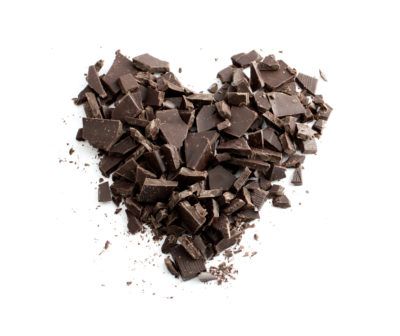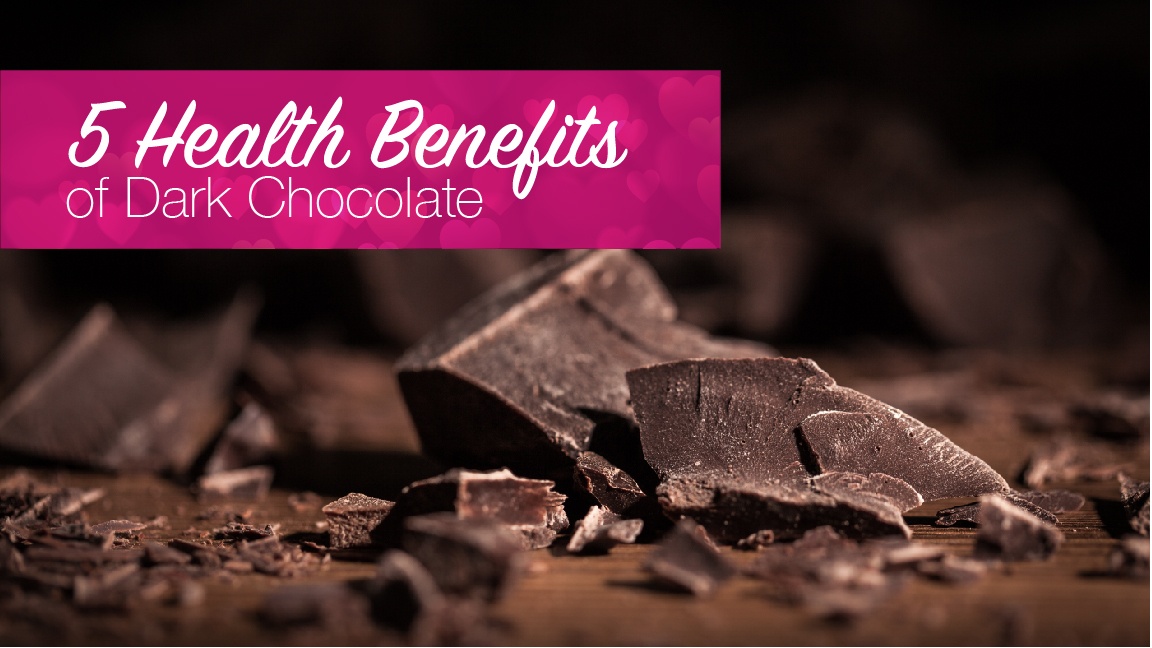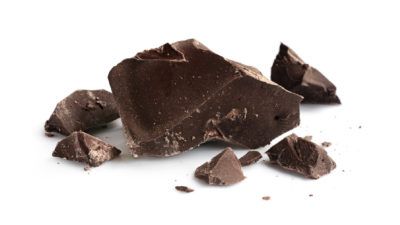5 Dark Chocolate Health Benefits
Valentine’s Day! Yay or groan, depending on your personal relationship with the holiday. Okay, by nature I’m a cynical person so fuzzy holidays tend to make my eyes roll REAL far in the back of my head. Last Valentine’s Day I ended up in the ER because of an allergic reaction. Not my favorite holiday.
But wait, my cynical brethren and opposing doe-eyed Valentine flunkies! Let’s focus on the most positive part of the holiday: the chocolate! More specifically, 5 dark chocolate health benefits.
It’s a popular topic, chocolate. So popular in fact that Americans spent $16 billion on chocolate in 2016. That means we ate about 2.8 billion pounds of it.
Last year 58 million pounds were purchased during the week leading up to Valentine’s Day. Rather than frantically running into the grocery store for some heart-shaped, over-processed chocolate, take some time and find some quality dark chocolate. I promise, your loved one will thank you for the thoughtful gift and you will sound even better when you can list off the health benefits.
What is Dark Chocolate
Unlike milk or white chocolate, dark has at least 70 percent cacao. It’s made from the seeds of a cacao tree. Generally, quality dark chocolate is minimally processed and has less sugar than milk or Dutch chocolate. The higher the percentage of cacao the greater the potential health benefits.
Everything in Moderation
The health benefits I’m about to break down are all centered around moderation. The recommended dose of dark chocolate for a healthy diet is one ounce a day. So don’t go running to your local Trader Joe’s to buy the massive block of dark chocolate and ingest it all in one sitting claiming the good people at What’s Up, USANA? told you to.

Five Health Benefits of Dark Chocolate
In moderation (an ounce a day), quality dark chocolate is loaded with some really impressive health benefits. And I’m not just saying this because I’m a self-proclaimed chocoholic…
- Anti-inflammatory properties
Dark chocolate is chock full of antioxidants which have been known to support a healthy inflammatory response. Okay, bear with me. It took me a little bit to digest this. Dark chocolate contains flavanols and polyphenols. The cocoa in dark chocolate has a higher content of polyphenols and flavonoids—way higher than wine or tea.
So what do antioxidants do anyway? We read that term all over food packaging. Antioxidants protect the body from damage caused by harmful molecules called free radicals. Free what? Free radicals. Free radicals can react with certain chemicals in the body. They may interfere with the ability of cells to work normally. So the flavanols and polyphenols found in dark chocolate combat this process.
- Supports heart health
In additional to flavanols’ antioxidant properties, they also have crazy potential for heart health. The Cleveland Clinic did some research that suggests flavanols help supports healthy blood pressure levels and blood flow in the heart. They also help support normal blood platelets count.
- Cholesterol
A Penn State study found that a diet of flavonoid-rich cocoa powder (dark chocolate) has “favorable” results on low-density lipoprotein (LDL), the commonly referred to bad cholesterol. Meaning, with a balanced diet and an average of one ounce a day, dark chocolate may help to maintain normal cholesterol levels.
“Furthermore, the inclusion of dark chocolate and cocoa powder in a diet that is rich in other food sources of antioxidants, such as fruit, vegetables, tea and wine, results in a high antioxidant intake and may consequently reduce the risk of cardiovascular disease,” says Kris Etherton, a professor of nutrition and also the leader of the Penn State study.
- JK Rowling was right…chocolate and brain waves
Cocoa, cocoa powders and dark chocolate all have high levels of flavonoids as already illustrated. And we already know flavonoids maintain healthy blood flow to the heart, but it also is associated with blood flow to cerebral gray matter.
Dark chocolate also contains magnesium, an essential mineral that can reduce temporary stress. It can actually help you relax.
Magnesium is largely missing from our diets but a one-ounce piece of dark chocolate contains 41mg of magnesium. That’s about half of your daily recommendation.
Magnesium is SUPER important to general wellness. Getting more magnesium from dark chocolate can also help with memory and even focus. You can read all about it in one of our other posts.
So JK was right when she instructed all millennials that chocolate makes the Dementors go away? Too much of a reach?

- Reduce Food Cravings
No, I’m not talking about the mass-produced, over-processed sugary chocolate. Genuine dark chocolate (70% cacao or more) is extremely filling. It’s far more filling than milk chocolate and lessens the cravings for sweet, salty and fatty foods, according to a study from the University of Copenhagen.
Again, remember moderation. So next time you want to stress-eat a burger or a whole pie, maybe try a small piece of dark chocolate and see what happens.
How to Choose the Best Chocolate:
- Check and make sure the dark chocolate contains at least 70-85 % cacao.
- Cacao is the first ingredient.
- A short ingredients list! More ingredients typically mean the chocolates been processed … a lot.
- Look for a brand that does not have sugar listed as the first ingredient. Sugar is a component, but it should NOT be the central ingredient.
What it All Means
A small amount of dark chocolate in your diet is great! Do some research and buy some quality dark chocolate for your loved one this Valentine’s (or for yourself). Hunker down for February 14 with said loved one, spouse, dog or cat (do not feed chocolate to the animals). And let us know here at the USANA social hub which brand you are jazzed about.

| *These statements have not been evaluated by the Food and Drug Administration. This product is not intended to diagnose, treat, cure, or prevent any disease. |
|---|
References
http://blog.marketresearch.com/valentines-day-spending-trends-and-statistics-infographic
http://mentalfloss.com/article/31222/numbers-how-americans-spend-their-money
http://my.clevelandclinic.org/health/articles/benefits-of-chocolate-heart-health
https://www.sciencedaily.com/releases/2001/10/011024073452.htm
http://jn.nutrition.org/content/139/1/120.full#ref-21
https://www.psychologytoday.com/blog/evolutionary-psychiatry/201106/magnesium-and-the-brain-the-original-chill-pill
https://www.sciencedaily.com/releases/2008/12/081210091039.htm



I love these informative posts that Usana distributes. However, as a literary specialist, I wish you would have them proofed before publication and, as a scientist by training, I wish your summary made sense.
How can you put together a plausible discussion with a mixture of ounces and grams?
Then, in the final slide, when we have the equivalent measures (which I understand we need to cover generations and geographies) the final figures relate to a “serving” totally different from that recommended earlier in the article!
Moderation of a good thing was the initial message—the final slide would lead some to believe that 3.5 ounces is a portion and others to believe they were getting 58% of their RDA magnesium from a daily dose of 1 ounce.
Consistency and accuracy produce real results and if they are not present, how can we encourage others to believe that Usana products are consistently and accurately produced?
There are other discrepancies such as the amount spent on chocolate annually versus the amount spent on the run up to Valentine’s day. Please get it right before sending to so many.
Hi Lisa, you raise some great points!
We aim to be consistent and accurate in all our information. The final slide you refer to; 3.5 ounces is the standard bar size of chocolate. Yes, I illustrate 1-ounce portion is the size for a healthy diet. The 3.5-ounce bar illustrates the normal size bar you can find in any store. In researching for the post I tried to look for single 1 ounce servings and they don’t really exist. I too had the very same concerns you brought up about the mixed message of different sizes which is why if you look closely at the 3.5 ounce image there is a sentence the states “This is a fairly large amount of chocolate and should not be consumed daily. This image illustrates the minerals that can be found in the entire bar not a 1 ounce serving.” Thank you so much for being so passionate about the USANA brand. I hope this clears up your questions.
Dark chocolate is having many health benefits. This article highlights almost all information about health benefits of dark chocolate. Thanks for sharing it.